The Godfather Part II
9.6 /10 2 Votes
4/4 Roger Ebert 80% Metacritic Genre Crime, Drama Duration Language EnglishSicilian | 9.1/10 IMDb 97% Rotten Tomatoes Film series The Godfather Country United States | |||||||||||||||||||||||||||||||||
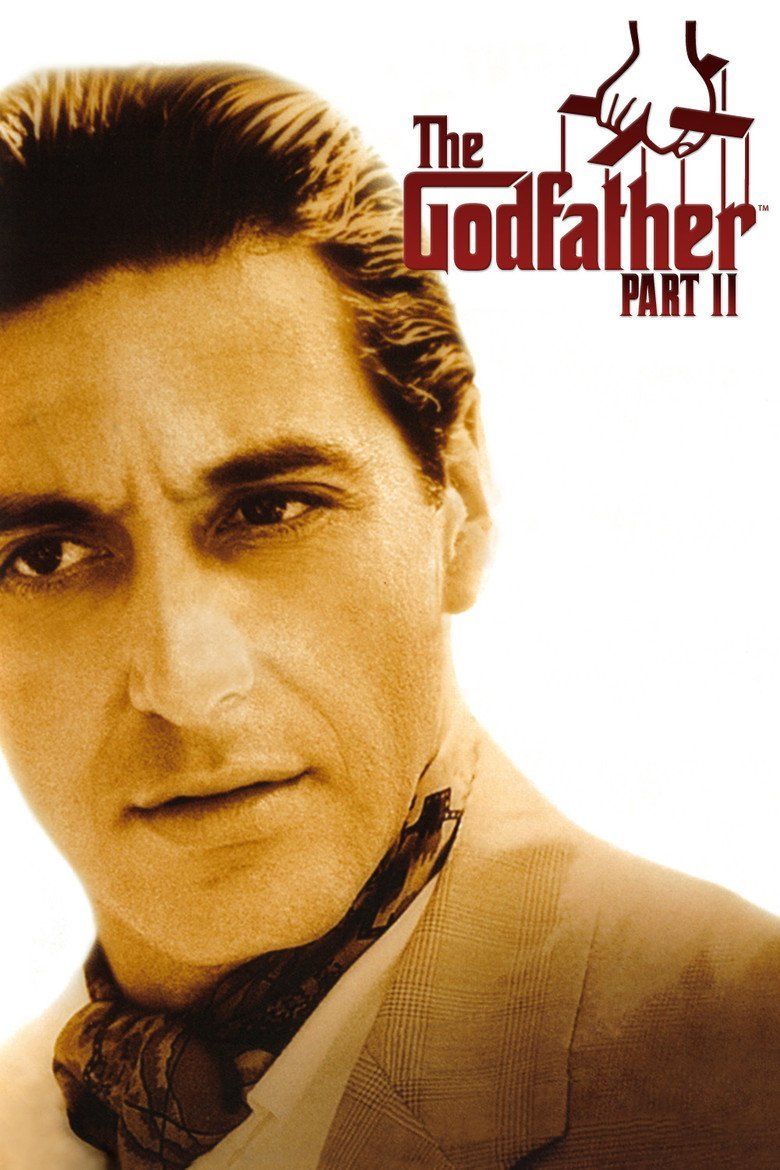 | ||||||||||||||||||||||||||||||||||
Release date December 12, 1974 (1974-12-12) (New York City)December 20, 1974 (1974-12-20) (United States) Writer Francis Ford Coppola (screenplay), Mario Puzo (screenplay), Mario Puzo (based on the novel "The Godfather" by) Initial release December 12, 1974 (New York City) Cast (Don Michael Corleone), (Tom Hagen), (Kay Corleone), (Vito Corleone), (Fredo Corleone), (Connie Corleone) Similar movies Mad Max: Fury Road , A Serbian Film , The Human Centipede 2 (Full Sequence) , John Wick , Things to Do in Denver When You're Dead , Taken 3 Tagline I don't feel I have to wipe everybody out, Tom. Just my enemies. | ||||||||||||||||||||||||||||||||||
The godfather part ii 1974 hd trailer
The Godfather Part II is a 1974 American crime film produced and directed by Francis Ford Coppola from a screenplay co-written with Mario Puzo, starring Al Pacino and Robert De Niro. Partially based on Puzo's 1969 novel The Godfather, the film is both sequel and prequel to The Godfather, presenting parallel dramas: one picks up the 1958 story of Michael Corleone (Pacino), the new Don of the Corleone crime family, protecting the family business in the aftermath of an attempt on his life; the prequel covers the journey of his father, Vito Corleone (De Niro), from his Sicilian childhood to the founding of his family enterprise in New York City.
Contents
- The godfather part ii 1974 hd trailer
- Plot
- Cast notes
- Production
- Reception
- Box office
- Releases for television and video
- Restoration
- Accolades
- American Film Institute recognition
- Video game
- References

The Godfather Part II opened to mixed reviews from critics, many of whom praised its cinematography while finding its nonlinear narrative disorganized. It was nominated for eleven Academy Awards, and became the first sequel to win for Best Picture. Its six Oscar wins included Best Director for Coppola, Best Supporting Actor for De Niro and Best Adapted Screenplay for Coppola and Puzo. Pacino won the BAFTA Award for Best Actor and was nominated for the Academy Award for Best Actor.
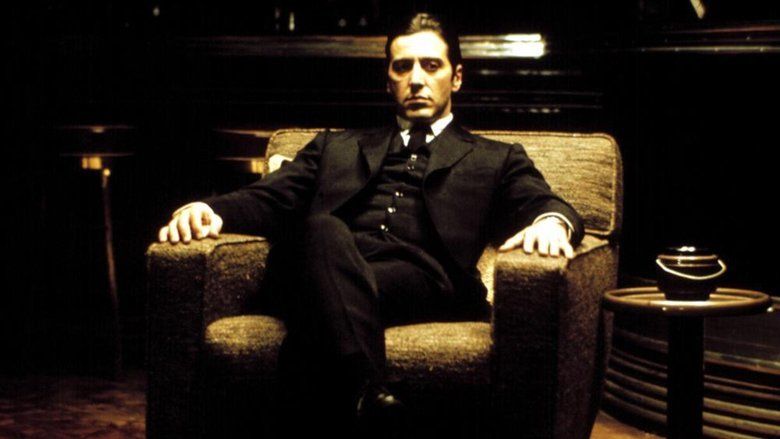
Both The Godfather Part II and its predecessor remain highly influential films in the gangster genre, and the former has been reevaluated. In 1997, the American Film Institute ranked it as the 32nd-greatest film in American film history and it retained this position 10 years later. Some have deemed it superior to the 1972 original. It was selected for preservation in the U.S. National Film Registry of the Library of Congress in 1993, being deemed "culturally, historically, or aesthetically significant".

The Godfather Part III, a later sequel, was released in 1990.
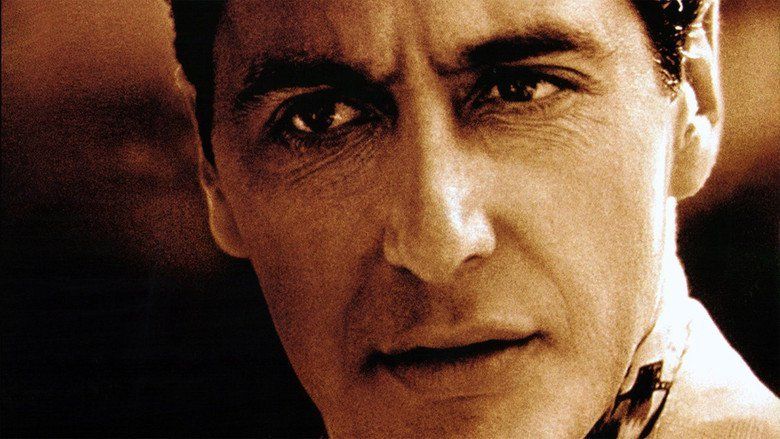
Plot
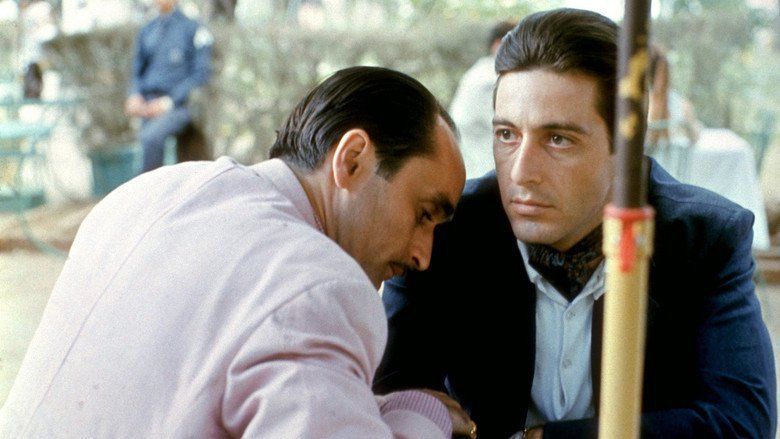
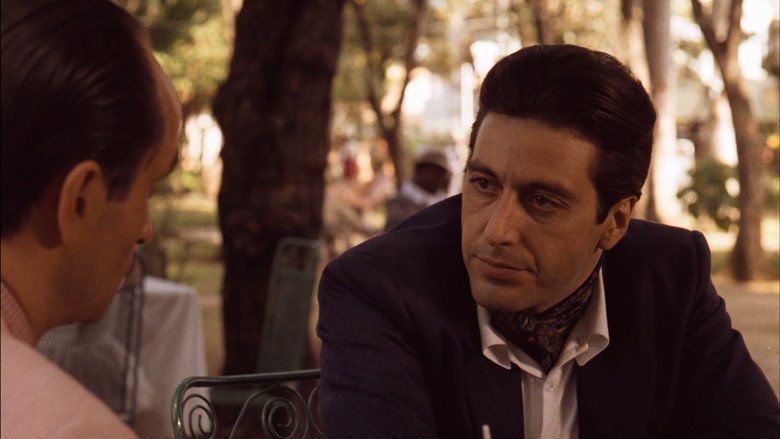
In 1958, during his son's First Communion party at Lake Tahoe, Michael Corleone has a series of meetings in his role as the Don of his crime family. Corleone caporegime Frank Pentangeli is dismayed that Michael will not help him defend his Brooklyn territory against the Rosato brothers, who work for Michael's business partner Hyman Roth. That night, Michael leaves Nevada after surviving an assassination attempt at his home.
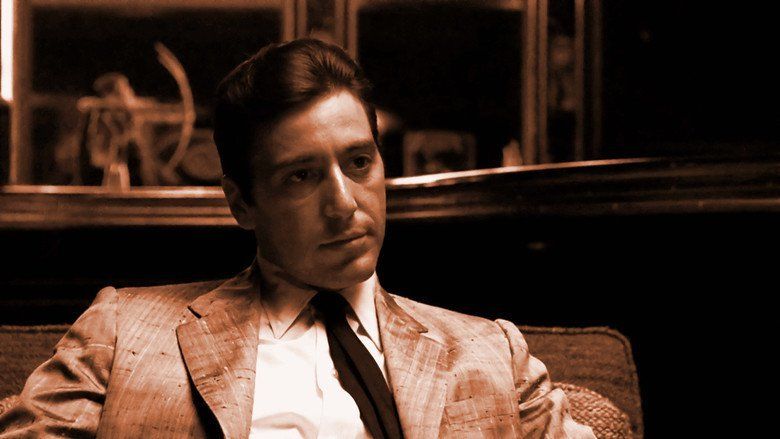
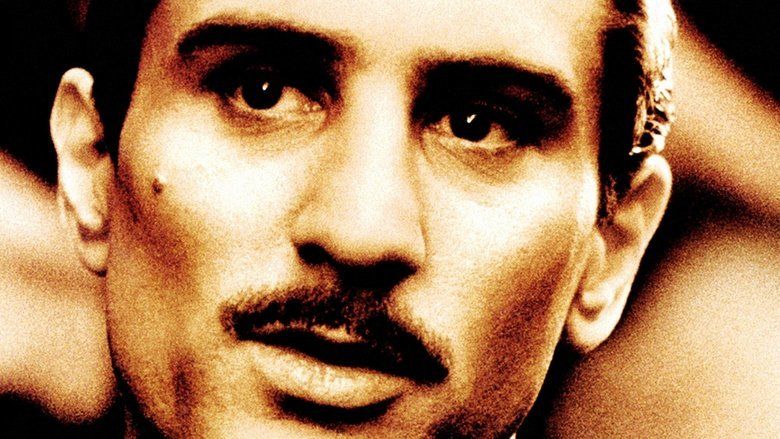
Michael suspects Roth of planning the assassination, but meets with him in Miami and feigns ignorance. In New York, Pentangeli attempts to maintain Michael's façade by making peace with the Rosato family but they attempt to kill him.
Roth, Michael, and several of their partners travel to Havana to discuss their future Cuban business prospects under the cooperative government of Fulgencio Batista; Michael becomes reluctant after reconsidering the viability of the ongoing Cuban Revolution. On New Year's Eve, he tries to have Roth and Roth's right-hand man Johnny Ola killed, but Roth survives when Michael's bodyguard is discovered and shot by police. Michael accuses his brother Fredo of betrayal after Fredo inadvertently reveals that he'd met with Ola previously. Batista abruptly abdicates due to rebel advances; during the ensuing chaos, Michael, Fredo, and Roth separately escape to the United States. Back home, Michael learns that his wife Kay has miscarried.
Three years later, Vito and Carmela have had two more sons, Fredo and Michael. Vito's criminal conduct attracts the attention of Fanucci, who extorts him. His partners, Clemenza and Salvatore Tessio, wish to avoid trouble by paying in full, but Vito insists that he can convince Fanucci to accept a smaller payment by making him "an offer he won't refuse". During a neighborhood festa, he stalks Fanucci to his apartment and shoots him dead.In Washington, D.C., a Senate committee on organized crime is investigating the Corleone family. Having survived the earlier attempt on his life, Pentangeli agrees to testify against Michael, who he believes had double-crossed him, and is placed under witness protection.
Now a respected figure in his community, Vito is approached for help by a widow who is being evicted. After an unsuccessful negotiation with Vito, the widow's landlord asks around, learns of Vito's reputation, and hastily agrees to let the widow stay on terms very favorable to her. In the meantime, Vito and his partners are becoming more and more successful, with the establishment of their business, "Genco Pura Olive Oil".Fredo is returned to Nevada, where he privately explains himself to Michael: resentful at being passed over to head the family, he helped Roth in expectation of something in return—unaware, he claims, of the plot on Michael's life. Michael responds by disowning Fredo.
Unable to get to the heavily-guarded Pentangeli, Michael instead brings Pentangeli's Sicilian brother to the hearing. On seeing his brother, Pentangeli denies his previous statements, and the hearing dissolves in an uproar. Afterwards, Kay reveals to Michael that her miscarriage was actually an abortion, and that she intends to take their children away from Michael's criminal life. Outraged, Michael takes custody of the children and banishes Kay from the family.
Vito visits Sicily for the first time since emigrating. He and business partner Tommasino are admitted to Don Ciccio's compound, ostensibly to ask for Ciccio's blessing on their olive oil business. Vito exacts his childhood vengeance by knifing Ciccio after revealing his old identity, but Tommasino is shot in the leg and suffers a permanent disability during their escape.Carmela Corleone dies. At the funeral, Michael appears to forgive Fredo but later orders caporegime Al Neri to assassinate him out on the lake.
Roth is refused asylum and even entry to Israel and is forced to return to the United States. Over the dissent of consigliere Tom Hagen, Michael sends caporegime Rocco Lampone to intercept and shoot Roth on arrival. Rocco is shot dead by federal agents after completing his mission.
At the witness protection compound, Hagen reminds Pentangeli that failed plotters against the Roman Emperor often committed suicide and assures him that his family will be cared for. Pentangeli later slits his wrists in his bathtub.
On December 7, 1941, the Corleone family gathers in their dining room to surprise Vito for his birthday. Michael announces that, in response to the attack on Pearl Harbor, he has left college and enlisted in the United States Marine Corps, leaving Sonny furious, Tom incredulous, and Fredo the only brother supportive. Vito is heard at the door and all but Michael leave the room to greet him.Michael sits alone by the lake at the family compound.
Cast notes
Production
The Godfather Part II was shot between October 1, 1973 and June 19, 1974, and was the last major American motion picture to have release prints made with Technicolor's dye imbibition process until the late 1990s. The scenes that took place in Cuba were shot in Santo Domingo, Dominican Republic. Charles Bluhdorn, whose Gulf+Western conglomerate owned Paramount, felt strongly about developing the Dominican Republic as a movie-making site.
The Lake Tahoe house and grounds portrayed in the film are Fleur du Lac, the summer estate of Henry J. Kaiser on the California side of the lake. The only structures used in the movie that still remain are the complex of old native stone boathouses with their wrought iron gates. Although Fleur du Lac is private property and no one is allowed ashore there, the boathouses and multimillion-dollar condominiums may be viewed from the lake.
Francis Ford Coppola originally wanted fellow director Elia Kazan to play Hyman Roth, but Kazan passed on the opportunity. On the DVD commentary track, Coppola detailed how he visited Kazan with the request, and remembered that Kazan was bare-chested. As an homage, in Roth's first scene, he is bare-chested when Michael Corleone visits him.
Unlike with the first film, Coppola was given near-complete control over production. In his commentary, he said this resulted in a shoot that ran very smoothly despite multiple locations and two narratives running parallel within one film.
Production nearly ended before it began when Pacino's lawyers told Coppola that he had grave misgivings with the script and was not coming. Coppola spent an entire night rewriting it before giving it to Pacino for his review. Pacino approved and the production went forward.
Coppola discusses his decision to make this the first major motion picture to use "Part II" in its title in the director's commentary on the DVD edition of the film released in 2002. Paramount was initially opposed because they believed the audience would not be interested in an addition to a story they had already seen. But the director prevailed, and the film's success began the common practice of numbered sequels.
Only three weeks prior to the release, film critics and journalists pronounced Part II a disaster. The cross-cutting between Vito and Michael's parallel stories were judged too frequent, not allowing enough time to leave a lasting impression on the audience. Coppola and the editors returned to the cutting room to change the film's narrative structure, but could not complete the work in time, leaving the final scenes poorly timed at the opening.
Reception
Initial critical reception of The Godfather Part II was divided, with some dismissing the work and others declaring it superior to the first film. While its cinematography and acting were immediately acclaimed, many criticized it as overly slow-paced and convoluted. Vincent Canby viewed the film as "stitched together from leftover parts. It talks. It moves in fits and starts but it has no mind of its own. [...] The plot defies any rational synopsis." Stanley Kauffmann of The New Republic accused the story of featuring "gaps and distentions [sic]." A mildly positive Roger Ebert wrote that the flashbacks "give Coppola the greatest difficulty in maintaining his pace and narrative force. The story of Michael, told chronologically and without the other material, would have had really substantial impact, but Coppola prevents our complete involvement by breaking the tension." Though praising Pacino's performance and lauding Coppola as "a master of mood, atmosphere, and period", Ebert considered the chronological shifts of its narrative "a structural weakness from which the film never recovers".
The film quickly became the subject of a critical reevaluation. Whether considered separately or with its predecessor as one work, The Godfather Part II is now widely regarded as one of the greatest films in world cinema. Many critics compare it favorably with the original – although it is rarely ranked higher on lists of "greatest" films. Roger Ebert retrospectively awarded it a full four stars in a second review and inducted the film into his Great Movies section, praising the work as "grippingly written, directed with confidence and artistry, photographed by Gordon Willis [...] in rich, warm tones." Michael Sragow's conclusion in his 2002 essay, selected for the National Film Registry web site, is that "[a]lthough “The Godfather” and “The Godfather Part II” depict an American family’s moral defeat, as a mammoth, pioneering work of art it remains a national creative triumph."
The Godfather Part II:
Many believe Pacino's performance in The Godfather Part II is his finest acting work, and the Academy of Motion Picture Arts and Sciences was criticized for awarding the Academy Award for Best Actor that year to Art Carney for his role in Harry and Tonto. It is now regarded as one of the greatest performances in film history. In 2006, Premiere issued its list of "The 100 Greatest Performances of all Time", putting Pacino's performance at #20. Later in 2009, Total Film issued "The 150 Greatest Performances of All Time", ranking Pacino's performance fourth place.
Box office
The Godfather Part II did not surpass the original film commercially, but in North America it grossed $47.5 million on a $13 million budget. It was Paramount Pictures' highest-grossing film of 1974 and was the fifth-highest-grossing picture in North America that year.
Releases for television and video
Coppola created The Godfather Saga expressly for American television in a 1975 release that combined The Godfather and The Godfather Part II with unused footage from those two films in a chronological telling that toned down the violent, sexual, and profane material for its NBC debut on November 18, 1977. In 1981, Paramount released the Godfather Epic boxed set, which also told the story of the first two films in chronological order, again with additional scenes, but not redacted for broadcast sensibilities. Coppola returned to the film again in 1992 when he updated that release with footage from The Godfather Part III and more unreleased material. This home viewing release, under the title The Godfather Trilogy 1901–1980, had a total run time of 583 minutes (9 hours, 43 minutes), not including the set's bonus documentary by Jeff Werner on the making of the films, "The Godfather Family: A Look Inside".
The Godfather DVD Collection was released on October 9, 2001 in a package that contained all three films—each with a commentary track by Coppola—and a bonus disc that featured a 73-minute documentary from 1991 entitled The Godfather Family: A Look Inside and other miscellany about the film: the additional scenes originally contained in The Godfather Saga; Francis Coppola's Notebook (a look inside a notebook the director kept with him at all times during the production of the film); rehearsal footage; a promotional featurette from 1971; and video segments on Gordon Willis's cinematography, Nino Rota's and Carmine Coppola's music, the director, the locations and Mario Puzo's screenplays. The DVD also held a Corleone family tree, a "Godfather" timeline, and footage of the Academy Award acceptance speeches.
The restoration was confirmed by Francis Ford Coppola during a question-and-answer session for The Godfather Part III, when he said that he had just seen the new transfer and it was "terrific".
Restoration
After a careful restoration of the first two movies, The Godfather movies were released on DVD and Blu-ray Disc on September 23, 2008, under the title The Godfather: The Coppola Restoration. The work was done by Robert A. Harris of Film Preserve. The Blu-ray Disc box set (four discs) includes high-definition extra features on the restoration and film. They are included on Disc 5 of the DVD box set (five discs).
Other extras are ported over from Paramount's 2001 DVD release. There are slight differences between the repurposed extras on the DVD and Blu-ray Disc sets, with the HD box having more content.
Accolades
This film was the first sequel to have won the Academy Award for Best Picture. The Godfather and The Godfather Part II remain the only original/sequel combination both to win Best Picture. Along with The Lord of the Rings, The Godfather Trilogy shares the distinction that all of its installments were nominated for Best Picture.
American Film Institute recognition
Video game
The video game based on the film was released in April 2009 by Electronic Arts.
References
The Godfather Part II WikipediaThe Godfather Part II IMDbThe Godfather Part II Roger EbertThe Godfather Part II Rotten TomatoesThe Godfather Part II MetacriticThe Godfather Part II themoviedb.org
